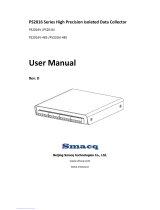
3
Table of Contents
Preface
About this User's Guide ....................................................................................................................... 5
What you will learn from this user's guide ......................................................................................................... 5
Conventions used in this user's guide ................................................................................................................. 5
Where to find more information ......................................................................................................................... 5
Chapter 1
Introducing the OMB-DAQ-2416-4AO ................................................................................................. 6
Overview: OMB-DAQ-2416-4AO features ....................................................................................................... 6
Software features ................................................................................................................................................ 6
Chapter 2
Installing the OMB-DAQ-2416-4AO ..................................................................................................... 7
What comes with your OMB-DAQ-2416-4AO shipment? ................................................................................ 7
Hardware .......................................................................................................................................................................... 7
Optional components ........................................................................................................................................................ 8
Additional documentation ................................................................................................................................................. 8
Unpacking the OMB-DAQ-2416-4AO .............................................................................................................. 8
Installing the software ........................................................................................................................................ 8
Installing the hardware ....................................................................................................................................... 8
Connecting to an OMB-AI-EXP32 with the DSUB37 expansion connector ..................................................... 9
Configuring the hardware ................................................................................................................................... 9
Connecting the board for I/O operations .......................................................................................................... 10
Connectors, cables – main I/O connector .........................................................................................................................10
Screw terminal pin out – differential ...............................................................................................................................11
Screw terminal pin out – single-ended .............................................................................................................................12
Chapter 3
Functional Details ............................................................................................................................... 13
OMB-DAQ-2416-4AO components ................................................................................................................. 13
LEDs ................................................................................................................................................................................14
USB connector .................................................................................................................................................................14
External power connector ................................................................................................................................................14
Screw terminal wiring ......................................................................................................................................................14
Mechanical drawings ........................................................................................................................................ 15
Block diagram .................................................................................................................................................. 16
Analog/TC input terminals ............................................................................................................................... 17
Analog input mode ...........................................................................................................................................................17
Thermocouple inputs .......................................................................................................................................................17
Noise filtering, data rate, and throughput rate ..................................................................................................................18
Multiple-channel throughput rates ...................................................................................................................................19
Input isolation ................................................................................................................................................... 20
Analog output terminals (VDAC0 through VDAC3) ....................................................................................... 21
Digital I/O ......................................................................................................................................................... 21
Internal pull-up/pull-down capability ..............................................................................................................................21
External pull-up/pull-down capability .............................................................................................................................22
Counter input terminals (CTR0, CTR1) ........................................................................................................... 23




















